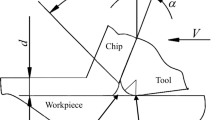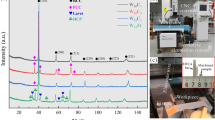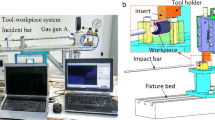Abstract
As the next generation of high-temperature materials, refractory high entropy alloys (RHEAs) have widespread application potential in aerospace and nuclear fusion fields, where the processing of RHEAs is important for their engineering applications. The cutting performance of WNbMoTaZr0.5 RHEA was studied, as compared with conventional bearing steel GCr15 and die steel Cr12MoV alloys. The effects of cutting parameters and corner radius on the cutting force, surface roughness, machined surface morphology, chip morphology, and chip parameters were analyzed. RHEA showed excellent thermal stability during machining, where the cutting forces and surface roughness have smaller variations with the increase in cutting speed than those of conventional GCr15 and Cr12MoV alloys. Differing from the machining of GCr15 and Cr12MoV, no work hardening was found during the machining of RHEA. Although RHEA had the largest cutting forces because of its high hardness, the surface roughness was relatively low. The influence of cutting depth on the surface roughness of WNbMoTaZr0.5 was small, suggesting that the machining efficiency can be enhanced by increasing the cutting depth without increasing the surface roughness. With the increase in cutting speed, the cutting temperature increased, enhancing the plasticity of the RHEA. This may result in the reduction of the scale-like patterns on the machined surface and the increase of the scale-like pattern size. Serrated chips were observed in the machining of RHEA. With the increase in cutting speed, the gap between shear bands decreased, leading to the concentration of burrs. With the accumulation of secondary shear bands, the internal stress increased, resulting in the rapid expansion of shear bands and the formation of primary shear bands. When the cutting speed was 70 m/min, the light emission phenomenon will be observed. The light emission process will generate burned patterns on the back surface of chips, and the EDS results showed that the elements of the chip surface were redistributed. The effect of cutting parameters and corner radius on the chip parameters in terms of width, thickness, and shear angle was comprehensively analyzed. Finally, adhesive wear was responsible for the main tool wear behavior of RHEA machining. The present findings can provide useful guidance for the machining and practical applications of RHEAs.


























Similar content being viewed by others

Data availability
The raw/processed data will be made available on request.
Code availability
Not applicable.
Abbreviations
- v :
-
Cutting speed
- f :
-
Feed rate
- a p :
-
Cutting depth
- Fx :
-
Axial force
- Fy :
-
Radial force
- Fz :
-
Main force
- \({\sigma }_{y}\) :
-
Yield strength
- \({\sigma }_{m}\) :
-
Maximum strength
- \({\varepsilon }_{f}\) :
-
Fracture strain
- γ 0 :
-
Rake angle
- κ r :
-
Side cutting edge angle
- r ε :
-
Corner radius
- Sy :
-
Horizontal projection
- Ra :
-
Surface roughness
- ϕ :
-
Chip shear angle
- h ch :
-
Chip thickness
- b ch :
-
Chip width
References
Miracle DB (2015) Critical assessment 14: high entropy alloys and their development as structural materials. Mater Sci Technol 31(10):1142–1147
Zhou ZY, Wang L, Zhao XH, Wu JL, Zhang F, Pi JH (2021) Effects of W addition on the corrosion behaviors of FeCoNiCrMn high entropy alloy composites in the 3.5 wt.% NaCl solution. Surf Interfaces 23:100956
Lv YK, Zhao XR, Shi T, Bai L, Chen J, Wang XH (2019) Excellent room temperature ductility of as-cast TRIP high-entropy alloy via Mo and C alloying. J Mater Sci 55:2239–2244
Chen SH, Qi C, Liu J, Zhang J, Wu Y (2022) Recent advances in W-containing refractory high-entropy alloys-an overview. Entropy 24(11):1553
Wei WC, Wang T, Wang CY, Wu M, Nie YP, Peng J (2021) Ductile W0.4MoNbxTaTi refractory high-entropy alloys with excellent elevated temperature strength. Mater Lett 295:129753
Rao RV (2006) Machinability evaluation of work materials using a combined multiple attribute decision-making method. Int J Adv Manuf Tech 28(3–4):221–227
Constantin G, Balan E, Voiculescu I, Geanta V, Craciun V (2020) Cutting behavior of Al0.6CoCrFeNi high entropy alloy. Materials 13(18):4181
Guo J, Goh M, Zhu ZG, Lee X, Nai MLS, Wei J (2018) On the machining of selective laser melting CoCrFeMnNi high-entropy alloy. Mater Des 153:211–220
Richter T, Schröpfer D, Rhode M, Börner A (2020) Infuence of modern machining processes on the surface integrity of high-entropy alloys. IOP Conf Ser Mater Sci Eng 882:012016
Litwa P, Hernandez-Nava E, Guan DK, Goodall R, Wika KK (2021) The additive manufacture processing and machinability of CrMnFeCoNi high entropy alloy. Mater Des 198:109380
Huang ZY, Dai YQ, Li Z, Zhang GQ, Chang CT, Ma J (2020) Investigation on surface morphology and crystalline phase deformation of Al80Li5Mg5Zn5Cu5 high-entropy alloy by ultra-precision cutting. Mater Des 186:108367
Doan DQ, Fang TH, Chen TH (2021) Machining mechanism and deformation behavior of high-entropy alloy under elliptical vibration cutting. Intermetallics 131:107079
Wang ZN, Li J, Fang QH, Liu B, Zhang LC (2017) Investigation into nanoscratching mechanical response of AlCrCuFeNi high-entropy alloys using atomic simulations. Appl Surf Sci 416:470–481
Chen GJ, Liu XL, Wang YS (2014) Changing boundaries of serrated chip in hard cutting GCr15 Steel. Mater Sci Forum 800–801:227–231
Ding F, Wang CY, Zhang T, Zheng LJ, Zhu XG, Li WR, Li L (2020) Investigation on chip deformation behaviors of Zr-based bulk metallic glass during machining. J Mater Process Technol 276:116404
Yang HD, Wu YS, Zhang JS, Tang HH, Chang WJ, Zhang JC, Chen SH (2022) Study on the cutting characteristics of high-speed machining Zr-based bulk metallic glass. Int J Adv Manuf Tech 119(5–6):3533–3544
Chen SH, Zhang JS, Guan S, Li T, Liu JQ, Wu FF, Wu YC (2022) Microstructure and mechanical properties of WNbMoTaZrx (x=0.1, 0.3 0.5, 1.0) refractory high entropy alloys. Mat Sci Eng A 835:142701
Han ZD, Luan HW, Liu X, Chen N, Li XY, Shao Y, Yao KF (2018) Microstructures and mechanical properties of TixNbMoTaW refractory high entropy alloys. Mat Sci Eng A 712:380–385
Kim H, Nam S, Roh A, Son M, Ham MH, Kim JH, Choi H (2019) Mechanical and electrical properties of NbMoTaW refractory high-entropy alloy thin films. Int J Refract Met H 80:286–291
Pramanik A, Littlefair G (2015) Machining of titanium alloy (Ti-6Al-4V)-theory to application. Mach Sci Technol 19(1):1–49
Chen SH, Ge Q, Zhang JS, Chang WJ, Zhang JC, Tang HH, Yang HD (2021) Low-speed machining of a Zr-based bulk metallic glass. J Manuf Process 72:565–581
Gu L, Wang M, Duan C (2013) On adiabatic shear localized fracture during serrated chip evolution in high speed machining of hardened AISI 1045 steel. Int J Mech Sci 75:288–298
Molnar TG, Berezvai S, Kiss AK, Bachrathy D, Stepan G (2019) Experimental investigation of dynamic chip formation in orthogonal cutting. Int J Mach Tool Manu 145:103429
Ren XQ, Li YG, Qi YF, Wang B (2022) Review on preparation technology and properties of refractory high entropy alloys. Materials 15(8):2931
Sim RK, Xu Z, Wu MY, He A, Chen DL, Li DY (2022) Microstructure, mechanical properties, corrosion and wear behavior of high-entropy alloy AlCoCrFeNix (x>0) and medium-entropy alloy (x=0). J Mater Sci 57:11949–11968
Wan YX, Wang X, Zhang ZB, Mo JY, Shen BL, Liang XB (2021) Structures and properties of the (NbMoTaW)(100–x) C-x high-entropy composites. J Alloy Compd 889:161645
Younas M, Jaffery SHI, Khan A, Khan M (2021) Development and analysis of tool wear and energy consumption maps for turning of titanium alloy (Ti6Al4V). J Manuf Process 62:613–622
Jaffery SHI, Mativenga PT (2012) Wear mechanisms analysis for turning Ti-6Al-4V-towards the development of suitable tool coatings. Int J Adv Manuf Tech 58(5–8):479–493
Funding
The work described in this paper was supported by the Natural Science Foundation of Anhui Province (grant number 2108085ME171) and the Fundamental Research Funds for the Central Universities (grant number JZ2022HGTB0247).
Author information
Authors and Affiliations
Contributions
Haidong Yang: conceptualization, methodology, validation. Xu Wang: material preparation, date collection. Junsheng Zhang: review, conceptualization, validation, writing original draft, and writing—review. Huohong Tang: writing—review and editing. Zhenhua Qing: material preparation, methodology, experimenting. Shunhua Chen: conceptualization, writing—review and editing.
Corresponding authors
Ethics declarations
Ethics approval
Not applicable.
Consent to participate
Not applicable.
Consent for publication
Not applicable.
Conflict of interest
The authors declare no competing interests.
Additional information
Publisher's Note
Springer Nature remains neutral with regard to jurisdictional claims in published maps and institutional affiliations.
Rights and permissions
Springer Nature or its licensor (e.g. a society or other partner) holds exclusive rights to this article under a publishing agreement with the author(s) or other rightsholder(s); author self-archiving of the accepted manuscript version of this article is solely governed by the terms of such publishing agreement and applicable law.
About this article
Cite this article
Yang, H., Wang, X., Zhang, J. et al. On the cutting performance and chip characteristics of WNbMoTaZr0.5 refractory high entropy alloy. Int J Adv Manuf Technol 128, 4893–4912 (2023). https://doi.org/10.1007/s00170-023-12252-w
Received:
Accepted:
Published:
Issue Date:
DOI: https://doi.org/10.1007/s00170-023-12252-w



